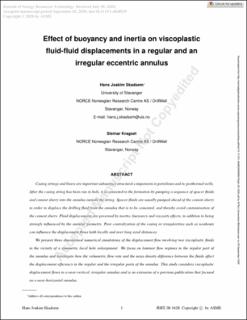Effect of buoyancy and inertia on viscoplastic fluid-fluid displacements in a regular and an irregular eccentric annulus
Peer reviewed, Journal article
Accepted version
Permanent lenke
https://hdl.handle.net/11250/2686056Utgivelsesdato
2020Metadata
Vis full innførselSamlinger
Originalversjon
10.1115/1.4048529Sammendrag
Casing strings and liners are important subsurface structural components in petroleum and in geothermal wells. After the casing string has been run in hole, it is cemented to the formation by pumping a sequence of spacer fluids and cement slurry into the annulus outside the string. Spacer fluids are usually pumped ahead of the cement slurry to displace the drilling fluid from the annulus that is to be cemented and thereby avoid contamination of the cement slurry. Fluid displacements are governed by inertia, buoyancy, and viscosity effects, in addition to being strongly influenced by the annular geometry. Poor centralization of the casing or irregularities such as washouts can influence the displacement flows both locally and over long axial distances. We present three-dimensional numerical simulations of the displacement flow involving two viscoplastic fluids in the vicinity of a symmetric local hole enlargement. We focus on laminar flow regimes in the regular part of the annulus and investigate how the volumetric flowrate and the mass density difference between the fluids affect the displacement efficiency in the regular and the irregular parts of the annulus. This study considers viscoplastic displacement flows in a near-vertical, irregular annulus and is an extension of a previous publication that focused on a near-horizontal annulus. We contextualize our simulations by comparison to industry guidelines for effective and steady laminar displacements in the regular, near-vertical annulus. Here, eccentricity favors flow in the wider sector of the annulus, while a positive density difference between the fluids generates secondary, azimuthal flow toward the narrow side of the annulus. In the enlarged and irregular section, both the axial bulk velocity and casing eccentricity decrease sharply and buoyancy becomes more pronounced compared to in the regular annulus. We quantify and discuss the effects of local hole enlargements on displacement efficiencies. Simulations of cementing flows can aid in optimizing fluid properties and pump rates, including when the wellbore has suspected or confirmed zones of irregular geometries.
